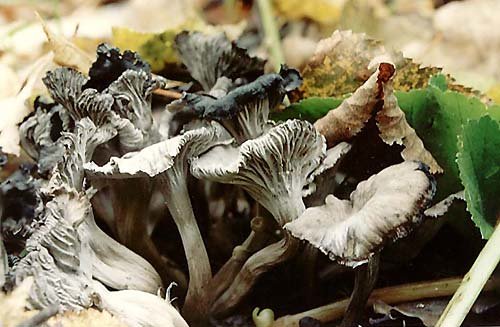Chanterelle gray (Cantharellus cinereus)
- Division: Basidiomycota (Basidiomycetes)
- Subdivision: Agaricomycotina (Agaricomycetes)
- Class: Agaricomycetes (Agaricomycetes)
- Subclass: Incertae sedis (of uncertain position)
- Order: Cantharellales (Chanterella (Cantarella))
- Family: Cantharellaceae (Cantharellae)
- Genus: Cantharellus
- Type: Cantharellus cinereus (Gray Chanterelle)
- Craterellus sinuousus

Chanterelle gray (Craterellus sinuosus)
Hat:
Funnel-shaped, with uneven wavy edges, diameter 3-6 cm. The inner surface is smooth, gray-brown; the outer is covered with lighter folds resembling plates. The pulp is thin, rubbery-fibrous, without a certain smell and taste.
Spore layer:
Folded, sinewy-lamellar, light, gray-ash, often with a light coating.
Spore powder:
Whitish.
Leg:
Smoothly turning into a hat, widened in the upper part, height 3-5 cm, thickness up to 0,5 cm. Color is gray, ash, gray-brown.
Spread:
The gray chanterelle is sometimes found in deciduous and mixed forests from late July to early October. Often grows in large clumps.
Similar species:
The gray chanterelle (almost) looks like a horn-shaped funnel (Craterellus cornucopiodes), which lacks plate-like folds (the hymenophore is actually smooth).
Edibility:
Edible, but actually a tasteless mushroom (as, indeed, the traditional yellow chanterelle – Cantharellus cibarius).









